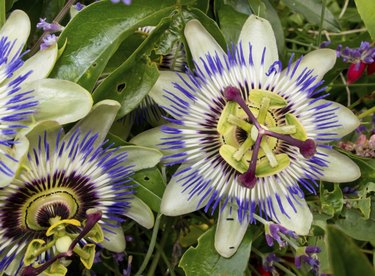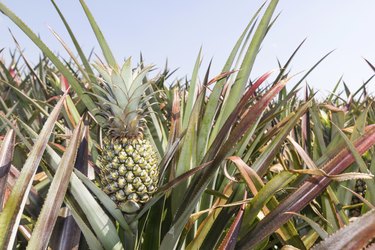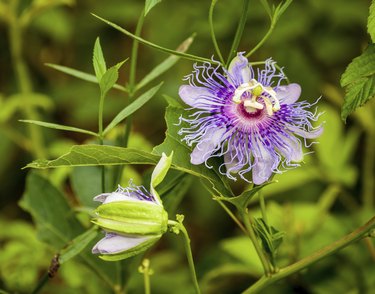
The rainforest houses more than two-thirds of the world's plant species, according to Cal Tech's Learning About Rainforests website. Plants within the rainforest must adapt to the wet, rainy conditions in addition to the heat and humidity thanks to the proximity to the equator that rainforests have. Commonly, rainforest plants feature a pointed drip tip to drain off excess water. Plants grow in stories, with the tallest canopy and emergent plants absorbing most of the light; understory and forest floor plants adapted to the lower light conditions below.
Pineapple
Video of the Day

The pineapple, Ananas comosus, originally grew as a rainforest plant. They grow on the floor of the rainforest, reaching 2.5 to 5 feet tall and 3 to 4 feet wide. Leaves of the pineapple plant are long, pointed and stiff. Flowers bloom on the plant in purple or red. Fruits produced by the pineapple plant have become an important exported crop.
Video of the Day
Bird’s Nest Fern

Asplenium nidus, or bird's nest fern, doubles as a rainforest floor plant and an understory plant, as it can grow on the ground or within a tree. The bird's nest fern forms in a rosette shape and features light green leaves. At full maturity, the sword-shaped fronds reach between 2 and 4 feet long, with a width of 3 to 8 inches.
Passion Flower

Flowers within the Passiflora genus, known as passion flowers, receive their name because of the reproductive organs of the plant resembling the crown of thorns worn by Jesus during the time before his crucifixion. Passion flowers grow in the understory of the rainforest as flowering vines. The vines feature large blooms during their flowering seasons that vary in color.
Curare

Chondrodendron tomentosum, known as curare or grieswurzel, grows within rainforest canopies. This plant's claim to fame is that it is commonly the source of the poison used for poison arrows. The roots and stems are crushed and mixed with other ingredients to make the poison. The vine grows to about 4 inches wide, with heart-shaped leaves and small, light green-tinted white flowers.
Strangler Fig Tree

The strangler fig tree, Ficus aurea, starts out its lift by growing on another tree. The tree climbs up the other tree and eventually kills the host tree. What is then left is a free-standing strangler fig with multiple trunks. At full size, strangler figs stretch over 6 feet tall. As a canopy tree, it can survive with partial shade. Flowers bloom on the strangler fig nearly continuously in order to allow rainforest animals, especially birds, to spread the seeds around the rainforest so new plants grow on hosts.
Kapok

Ceiba pentandra, the kapok tree, stands tall in the rainforest's emergent layer. At over 150 feet when mature, the kapok tree features an umbrella-shaped crown and big spines on its trunk. During the dry season, the tree loses almost all of its leaves. Flowers bloom in either pink or white but have an unpleasant smell. Rainforest natives use kapok tree trunks for canoes, while using seed-covering fluff to stuff pillows and mattresses.
- Blue Planet Biomes: Curare
- Michigan State University: Passion Flower
- Floridata: Ficus aurea
- Purdue University Center for New Crops and Plant Products: Pineapple
- University of Hawaii at Manoa College of Tropical Agriculture and Human Resources: Asplenium nidus
- Blue Planet Biomes: Kapok Tree
- Cal Tech: Learing About Rainforests: The Plants of the Rainforest